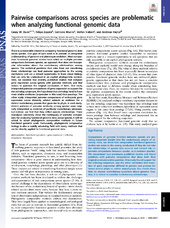| dc.contributor.author | Dunn, Casey W. | |
| dc.contributor.author | Zapata, Felipe | |
| dc.contributor.author | Munro, Catriona | |
| dc.contributor.author | Siebert, Stefan | |
| dc.contributor.author | Hejnol, Andreas | |
| dc.date.accessioned | 2019-02-26T16:58:42Z | |
| dc.date.available | 2019-02-26T16:58:42Z | |
| dc.date.issued | 2018-01-04 | |
| dc.Published | Dunn CW, Zapata F, Munro, Siebert S, Hejnol A. Pairwise comparisons across species are problematic when analyzing functional genomic data. Proceedings of the National Academy of Sciences of the United States of America. 2018;115(3):E409-E417 | eng |
| dc.identifier.issn | 0027-8424 | |
| dc.identifier.issn | 1091-6490 | |
| dc.identifier.uri | https://hdl.handle.net/1956/19152 | |
| dc.description.abstract | There is considerable interest in comparing functional genomic data across species. One goal of such work is to provide an integrated understanding of genome and phenotype evolution. Most comparative functional genomic studies have relied on multiple pairwise comparisons between species, an approach that does not incorporate information about the evolutionary relationships among species. The statistical problems that arise from not considering these relationships can lead pairwise approaches to the wrong conclusions and are a missed opportunity to learn about biology that can only be understood in an explicit phylogenetic context. Here, we examine two recently published studies that compare gene expression across species with pairwise methods, and find reason to question the original conclusions of both. One study interpreted pairwise comparisons of gene expression as support for the ortholog conjecture, the hypothesis that orthologs tend to have more similar attributes (expression in this case) than paralogs. The other study interpreted pairwise comparisons of embryonic gene expression across distantly related animals as evidence for a distinct evolutionary process that gave rise to phyla. In each study, distinct patterns of pairwise similarity among species were originally interpreted as evidence of particular evolutionary processes, but instead, we find that they reflect species relationships. These reanalyses concretely show the inadequacy of pairwise comparisons for analyzing functional genomic data across species. It will be critical to adopt phylogenetic comparative methods in future functional genomic work. Fortunately, phylogenetic comparative biology is also a rapidly advancing field with many methods that can be directly applied to functional genomic data. | en_US |
| dc.language.iso | eng | eng |
| dc.publisher | National Academy of Sciences | eng |
| dc.rights | Attribution CC BY-NC-ND | eng |
| dc.rights.uri | https://creativecommons.org/licenses/by-nc-nd/4.0/ | eng |
| dc.subject | phylogenetics | eng |
| dc.subject | functional genomics | eng |
| dc.subject | gene expression | eng |
| dc.subject | ortholog conjecture | eng |
| dc.subject | hourglass | eng |
| dc.title | Pairwise comparisons across species are problematic when analyzing functional genomic data | eng |
| dc.type | Journal article | eng |
| dc.type | Peer reviewed | eng |
| dc.date.updated | 2018-09-15T03:49:17Z | |
| dc.description.version | publishedVersion | |
| dc.rights.holder | Copyright 2018 The Authors | eng |
| dc.identifier.doi | https://doi.org/10.1073/pnas.1707515115 | |
| dc.identifier.cristin | 1609748 | |
| dc.source.journal | Proceedings of the National Academy of Sciences of the United States of America | |

